Imagine biting into something that breaks all the rules. Where pizza’s crispness meets sushi’s finesse. Sushi pizza is a bold mix of Japanese and Italian cooking. It’s a dish that excites your taste buds and shows how different cultures can come together in food.
It’s the brainchild of chefs who love to try new things. pizza turns common ingredients into something truly special. Whether you love sushi or pizza, this dish will amaze you with its unique twist on international flavors.
Table of contents
- The Origins and Evolution of Sushi Pizza
- Understanding Fusion Cuisine’s Impact on Modern Dining
- What Makes Sushi Pizza Unique
- Essential Components of Traditional Sushi vs Sushi Pizza
- The Art of Making Perfect Sushi Rice
- Creative Toppings and Combinations
- Mastering the Assembly Process
- Health Benefits and Nutritional Value
- Popular Variations Around the World
- Best Practices for Serving and Eating
- Conclusion
The Origins and Evolution of Sushi Pizza
Culinary innovation often comes from unexpected places. Sushi pizza is a great example of Toronto’s creative food scene. It’s a mix of Japanese and Italian flavors, changing how we enjoy food.
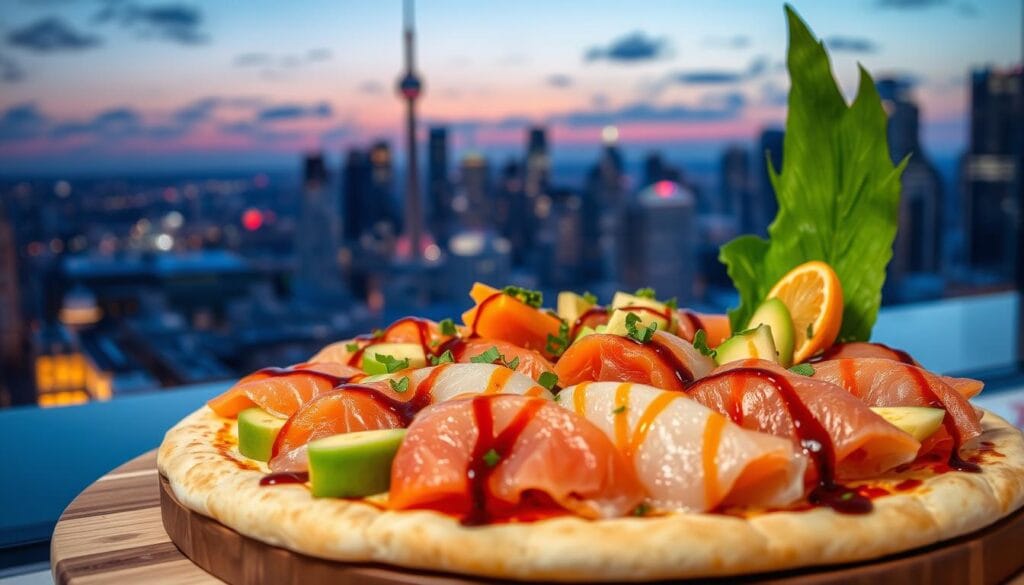
The story of sushi pizza begins in Toronto’s diverse food scene. Chef Kaoru Ohsada was at the forefront, blending sushi with pizza. He turned traditional sushi into something new and exciting.
Toronto’s Culinary Breakthrough
In Toronto’s downtown, Ohsada created a dish that amazed food lovers. He used sushi rice instead of pizza dough. This made a crispy base that was unlike anything before.
Chef Kaoru Ohsada’s Innovative Approach
Ohsada’s creativity went beyond just using different ingredients. His approach included:
- Using perfectly seasoned sushi rice as a crispy foundation
- Incorporating fresh seafood toppings
- Blending traditional Japanese and Western culinary techniques
Global Recognition and Spread
What started in Toronto became a global hit. Sushi Stack restaurants popped up in cities all over the world. It showed that new food ideas can reach everyone.
The dish’s fame comes from its surprise and delight. It offers a unique dining experience that brings together different cultures.
Understanding Fusion Cuisine’s Impact on Modern Dining
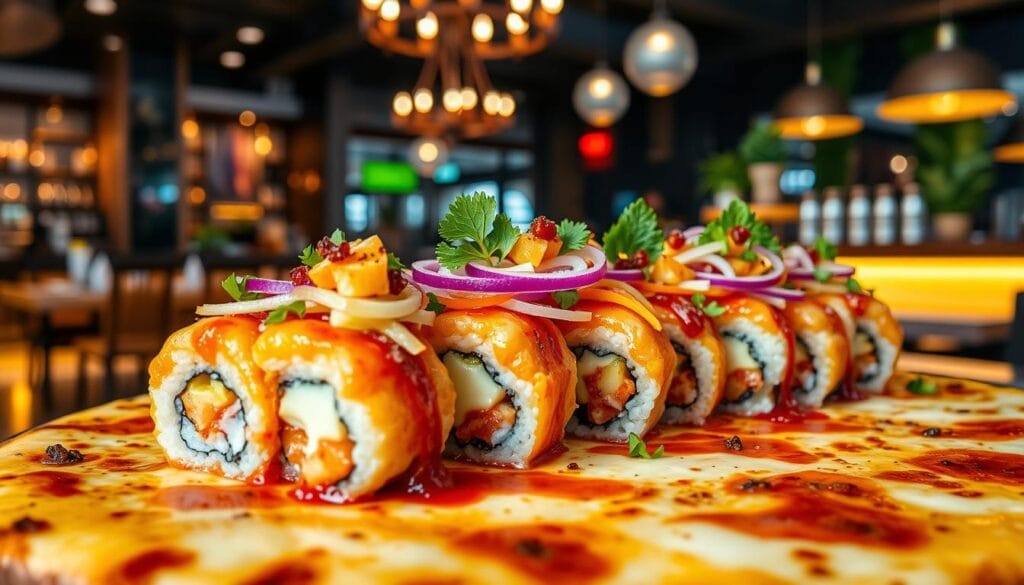
Fusion cuisine has changed how we enjoy food. It mixes different cooking styles to create new tastes. Japanese-Italian fusion is a great example, blending two cultures to make unique dishes.
For decades, chefs like Wolfgang Puck have been mixing flavors in new ways. This has made food more exciting and adventurous for diners.
- Fusion dishes attract adventurous diners by giving them new tastes.
- Social media has made creative food styles more popular.
- About 55% of people like to eat meals that look good and can be shared.
Young people, or Generation Z, love trying new foods. They’re eager to taste different flavors, with 65% of 18-35-year-olds excited about new dishes. This has made restaurants offer more diverse menus, including Japanese-Italian fusion.
The global flavors market is growing fast. It was worth USD 18.75 billion in 2023 and is expected to hit USD 30.10 billion by 2032. This shows people want to try new and exciting foods.
| Fusion Cuisine Trend | Impact |
|---|---|
| Menu Diversification | 25% increase in restaurants |
| Culinary Awards | 40% increase for innovative dishes |
| Social Media Influence | 55% of diners attracted by visual appeal |
Fusion cuisine is more than a trend. It celebrates creativity in cooking and brings different cultures together. It invites us to try new foods and enjoy exciting flavors.
What Makes Sushi Pizza Unique
is a new twist in food that breaks old rules. It mixes Japanese flavors with pizza, making it a hit with food lovers everywhere.
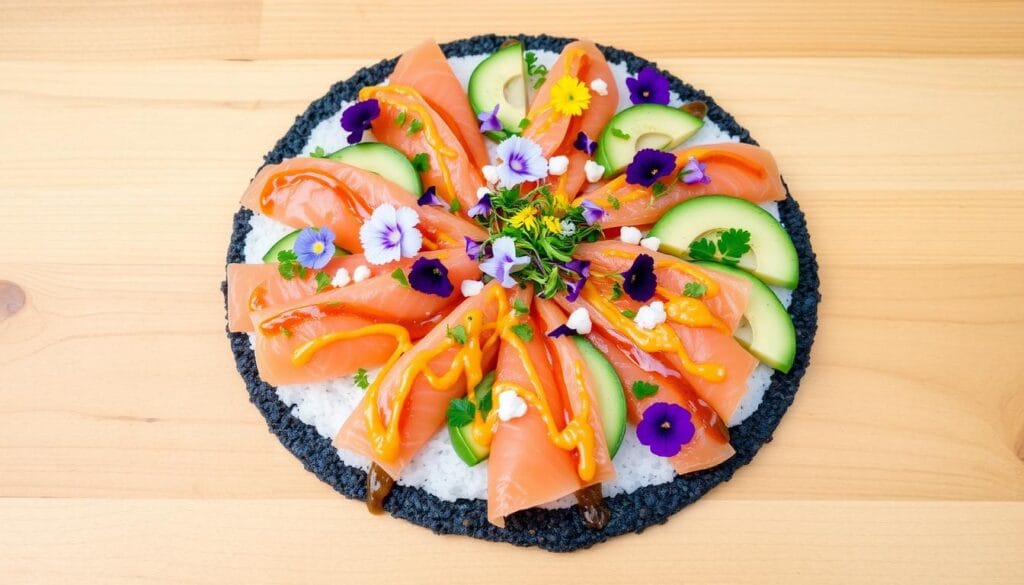
The secret of sushi is its special parts. It starts with a crispy rice base, unlike regular pizzas.
The Crispy Rice Base
Making a great pizza begins with the rice base. Here’s how to do it:
- Use 2 cups of cooked sushi rice
- Press rice into a compact base approximately 1/2 inch thick
- Refrigerate the base for 15-20 minutes to help it set
- Achieve a golden, crispy exterior through careful preparation
Fresh Toppings and Garnishes
For those who love raw fish,has great toppings. Try these:
| Protein Options | Vegetarian Alternatives |
|---|---|
| 4 ounces sushi-grade salmon | Marinated tofu |
| Sushi-grade tuna | Sliced mango |
Signature Sauces and Flavors
Make your avocado pizza special with Japanese flavors. Try wasabi pizza with:
- 1/4 cup diced cucumber
- 1/2 avocado, sliced or diced
- 1 teaspoon sesame seeds for garnish
- Optional: Spicy mayo or wasabi drizzle
Whether you make mini sushi pizzas or a big one, it’s a dish that will leave a lasting impression. It brings together different cooking styles in a unique way.
Essential Components of Traditional Sushi vs Sushi Pizza
is a mix of Japanese traditions and new food ideas. It takes classic sushi and turns it into something new and exciting. This dish uses familiar ingredients in a fresh way.
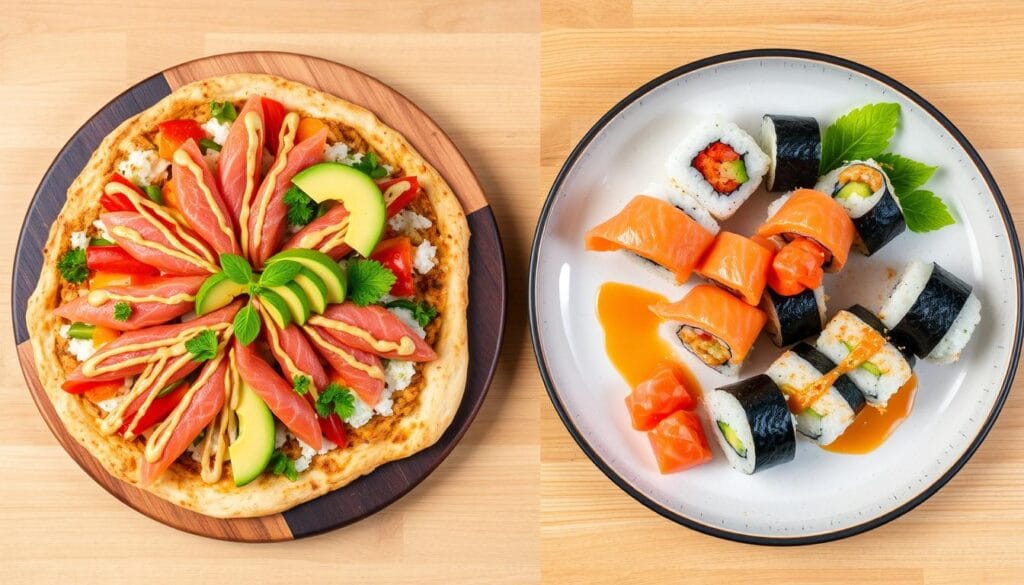
- Vinegared rice (shari)
- Fresh raw fish or seafood
- Nori seaweed
- Wasabi and pickled ginger
But pizza is different. It uses a crispy rice cake instead of sushi rice. This makes it more like a pizza. Then, it’s topped with ingredients found in traditional sushi.
In Japan, pizza toppings are unique. Sushi pizza often has:
- Salmon or tuna
- Avocado
- Spicy mayo
- Tobiko (fish roe)
- Microgreens or fresh herbs
This mix of flavors and textures is amazing. Each bite is crispy and fresh, blending old and new in a tasty way.
The Art of Making Perfect Sushi Rice
Making a great sushi pizza starts with the rice. Your recipe needs the right rice, prepared with care. The foundation of a sushi pizza ingredients list is rice preparation.
Rice Selection Matters
Choosing the right rice is key for your pizza. Short-grain Japanese rice is the best choice. It makes a sticky base for your pizza.
- Choose short-grain Japanese rice
- Look for varieties labeled as sushi rice
- Avoid long-grain or medium-grain alternatives
Precise Cooking Techniques
Cooking sushi rice needs focus. The rice-to-water ratio is important for the right texture. Use a 1:1.25 ratio for perfect cooking.
| Step | Detail |
|---|---|
| Rinsing | Rinse rice until water runs clear |
| Water Ratio | 1 cup rice to 1.25 cups water |
| Cooking Time | 15-20 minutes |
| Resting Time | 10 minutes after cooking |
Seasoning for Flavor
Seasoning makes sushi rice special. Mix rice vinegar, sugar, and salt for flavor. Gently fold the seasoning into warm rice for even flavor.
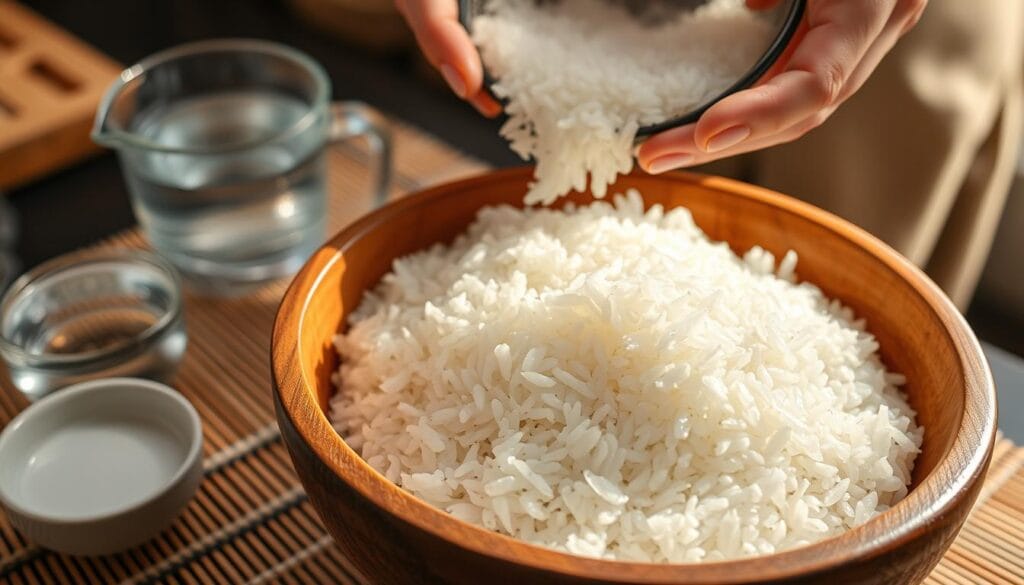
By mastering these steps, you’ll make a perfect rice base. This elevates your sushi pizza to new heights. The right rice is the secret to a great pizza.
Creative Toppings and Combinations
When making the best sushi pizza, let your creativity flow. Try new toppings and flavors. Seafood pizza fans will find endless exciting options that make sushi pizza special.
Salmon pizza lovers, here are some tasty toppings to try:
- Fresh sashimi-grade salmon slices
- Spicy sriracha mayo drizzle
- Crispy tempura flakes
- Pickled cucumber ribbons
- Toasted sesame seeds
Creating a great seafood pizza is all about mixing textures and tastes. Tuna, yellowtail, and shrimp are great alternatives to salmon. Each adds its own flavor to your pizza.
Here are some top flavor combos:
- Smoked salmon with cream cheese and capers
- Tuna with avocado and wasabi aioli
- Yellowtail with ponzu sauce and scallions
Remember, use only the freshest seafood for the best sushi pizza. Try different marinades, garnishes, and sauces to make your dish stand out.
Mastering the Assembly Process
Making a perfect pizza recipe needs precision and creativity. It involves several key steps. These steps turn simple ingredients into a culinary masterpiece.
Base Construction Tips
The foundation of a great sushi pizza starts with perfect sushi rice. Your rice base should be compact yet delicate. It should have a crispy texture that’s perfect for toppings.
- Use short-grain sushi rice for best results
- Press rice firmly into a circular mold
- Pan-fry the rice base until golden and crispy
- Ensure even thickness across the base
Layering Techniques
When assembling your pizza, strategic ingredient placement is key. Think of each layer as a chance to build flavor and visual appeal.
- Start with a thin spread of wasabi mayo
- Add thinly sliced sashimi or cooked seafood
- Sprinkle with fresh herbs
- Drizzle with specialized sauces
Final Presentation
Your pizza’s look is as important as its taste. Aim for a balanced, colorful arrangement. This should showcase the ingredients.
| Presentation Element | Recommended Technique |
|---|---|
| Garnish | Microgreens, sesame seeds |
| Sauce Drizzle | Zig-zag pattern |
| Cutting | Use sharp knife, slice into wedges |
With practice, your homemade sushi pizza will impress everyone. It will delight friends and family with its unique flavors and textures.
Health Benefits and Nutritional Value
Wondering if it’s okay to eat poke? Sushi pizza is a healthy choice instead of regular pizza. It mixes fresh fish and veggies in a tasty way.
is great for those who care about their health. It’s like poke pizza but with different ingredients. Both offer lots of nutrients.
- Rich in omega-3 fatty acids from fresh fish
- High in protein from seafood toppings
- Low in calories compared to traditional pizza
- Packed with essential vitamins and minerals
Nutritional breakdown shows big health benefits:
| Nutrient | Benefit | Quantity per Serving |
|---|---|---|
| Omega-3 Fatty Acids | Heart and Brain Health | 500-750 mg |
| Protein | Muscle Development | 15-20 grams |
| Vitamin D | Bone Strength | 200-300 IU |
Safety tip: Always get raw fish from trusted places. Make sure to handle food safely.
People with special diets should talk to nutritionists. They can help figure out how sushi pizza fits into your health plan. It’s a meal full of fresh ingredients that’s good for you.
Popular Variations Around the World
has become a global hit, with each place adding its own special touch. It has traveled across continents, showing how local tastes and traditions change it.
Regional Adaptations
Cities around the world have made sushi pizza their own. In Brasil, chefs use peixe fresco and tropical fruits. Seattle adds Pacific Northwest seafood, and Chicago goes for a Midwestern twist with thick rice and hearty toppings.
- Brasil: Tropical fruit and fresh fish garnishes
- Seattle: Pacific salmon and local herb infusions
- Chicago: Deep-dish inspired thick rice bases
Cultural Influences
Culture plays a big role in how sushi is made. Each area puts its own spin on it, making new and exciting flavors.
| Region | Unique Characteristic | Signature Ingredient |
|---|---|---|
| Brasil | Tropical fusion | Passion fruit sauce |
| Seattle | Seafood emphasis | Wild-caught salmon |
| Chicago | Hearty presentation | Thick rice base |
Innovative Interpretations
Chefs everywhere are making sushi pizza their own. They’re trying new toppings, rice styles, and flavor mixes. This makes sushi pizza a true culinary art.
- Fusion of traditional techniques
- Unexpected ingredient combinations
- Creative presentation styles
Best Practices for Serving and Eating
Enjoying pizza is special. It mixes traditional sushi ways with new pizza ideas. Knowing how to serve it right makes your meal better.
Here are some key tips for serving and enjoying sushi pizza:
- Serve at the perfect temperature – a bit cool to keep rice crunchy
- Use clean, sharp tools for cutting
- Pair with light sides like pickled veggies or a fresh salad
Is fish pizza a thing? Yes! The food world keeps getting creative. When trying cheese sushi or other mix-ups, follow these serving tips:
| Serving Technique | Recommendation |
|---|---|
| Portion Size | Cut into 4-6 easy-to-handle pieces |
| Presentation | Use flat, wide plates to show off the dish |
| Garnish | Add fresh herbs or microgreens |
Eating manners are important. Use chopsticks or your hands, based on the place’s style. Pro tip: Take small bites to enjoy the mix of flavors and textures in your sushi pizza.
Remember, sushi is a special experience. It’s meant to be savored slowly. Each bite is a story of creativity and blending cultures.
FAQ
What exactly is sushi pizza?
Where did sushi pizza originate?
Is sushi pizza safe to eat?
What are the typical ingredients in a sushi pizza?
How is sushi pizza different from traditional sushi?
Can I make sushi pizza at home?
Is sushi pizza healthy?
Are there vegetarian versions of sushi pizza?
Where can I find sushi pizza?
What makes the rice base of sushi pizza different?
Conclusion
is more than a dish; it’s a sign of creative cooking that goes beyond usual limits. It started in Toronto and now is loved worldwide. You might have seen it in sushi pizza kitchen nightmares, where chefs dare to try new things.
Unlike traditional pizza, sushi pizza doesn’t have holes. Its rice base changes the game. You can make it with tofu for vegetarians or add gourmet ingredients for seafood lovers. It’s not tied to any one place, unlike New Jersey pizza.
Sushi pizza shows how food can change and grow. It’s perfect for anyone who loves trying new things. Every bite is a mix of cultures, creativity, and fun.

